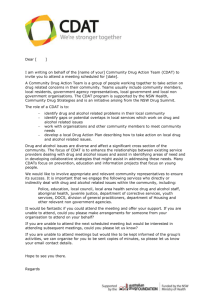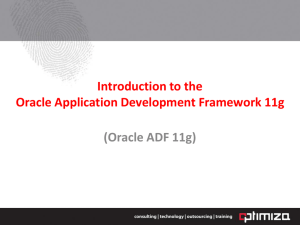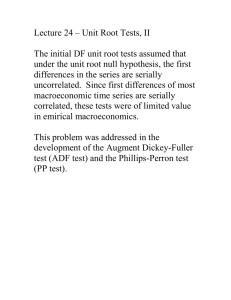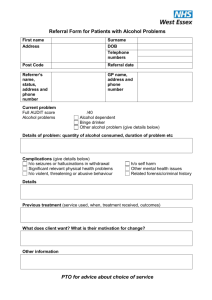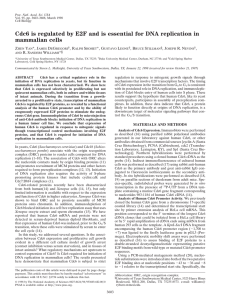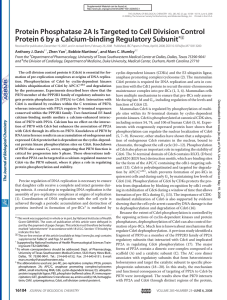project management plan
advertisement
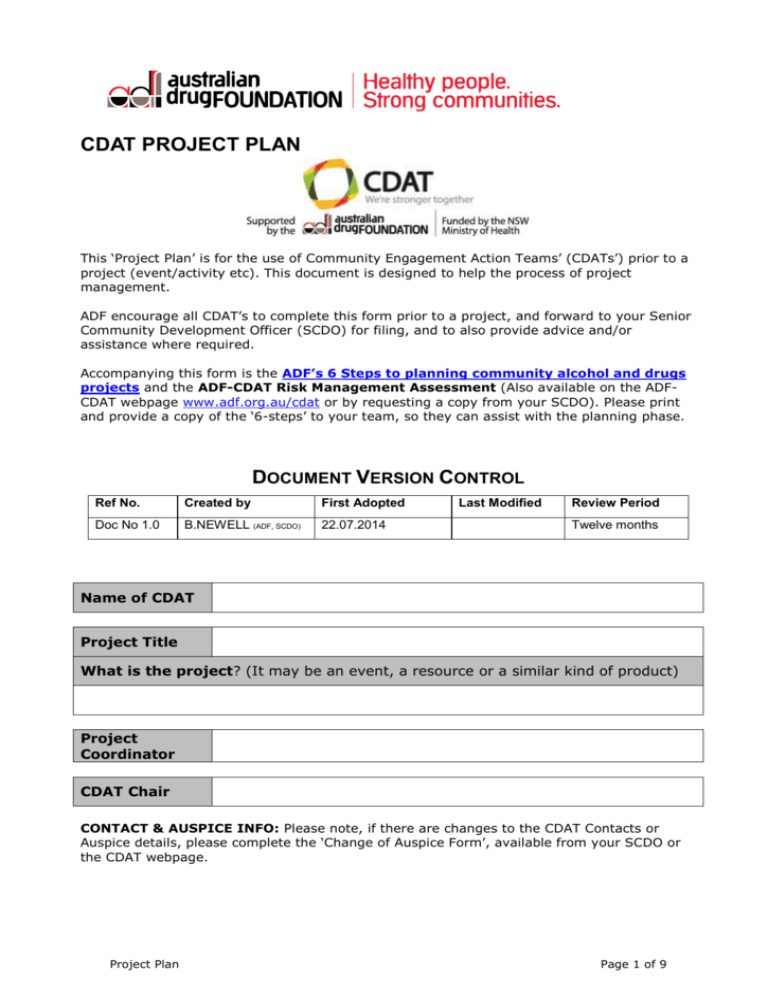
CDAT PROJECT PLAN This ‘Project Plan’ is for the use of Community Engagement Action Teams’ (CDATs’) prior to a project (event/activity etc). This document is designed to help the process of project management. ADF encourage all CDAT’s to complete this form prior to a project, and forward to your Senior Community Development Officer (SCDO) for filing, and to also provide advice and/or assistance where required. Accompanying this form is the ADF’s 6 Steps to planning community alcohol and drugs projects and the ADF-CDAT Risk Management Assessment (Also available on the ADFCDAT webpage www.adf.org.au/cdat or by requesting a copy from your SCDO). Please print and provide a copy of the ‘6-steps’ to your team, so they can assist with the planning phase. DOCUMENT VERSION CONTROL Ref No. Created by First Adopted Doc No 1.0 B.NEWELL (ADF, SCDO) 22.07.2014 Last Modified Review Period Twelve months Name of CDAT Project Title What is the project? (It may be an event, a resource or a similar kind of product) Project Coordinator CDAT Chair CONTACT & AUSPICE INFO: Please note, if there are changes to the CDAT Contacts or Auspice details, please complete the ‘Change of Auspice Form’, available from your SCDO or the CDAT webpage. Project Plan Page 1 of 9 PROJECT MANAGEMENT Project Management – Please identify who will be responsible (coordinator) for the following aspects of the project (various sections of this document) SECTION 1: Networking SECTION 2: Gathering statistics SECTION 3: Community engagement SECTION 4: Identify best approach Media & Promotion: SECTION 5: Planning & Insurance Child Protection: Risk Management Assessment & Monitoring: SECTION 6: Evaluation Financial/budget For full ‘Project Management Plan’, see ‘Section5, Table A’, at the end of this document. SECTION 1: NETWORK What other initiatives already exist? Eg. Local, state and/or national projects of similar naure. Who can help you, and how? Who should we approach? (consider approaching these local groups or organisations) (add your own, above) Inter-agencies Aboriginal Health & community services Local Council/s Major Employers Traders and Business Associations Primary Care Partnerships Schools Alcohol and Drug Workers Non-government Health and Human Services Agencies Community Development, Health Promotion and Youth Workers Lions, Rotary and Apex Clubs General Practitioners, Pharmacists, Dentists and Hospitals Police and other emergency services Residents Groups (Neighbourhood Watch, Progress Associations etc) Other influential individuals (check local media) Other Notes: IDENTIFY PROJECT PARTNERS/ STAKEHOLDERS Identify all agencies contributing to this project Other Notes: Project Plan Page 2 of 9 SECTION 2: GATHER STATISTICS Ask yourselves, Is the perception of the problem accurate? How can the problem be explained using statistics? Consider approaching: Council(s), and ask for the planning, recreation or youth officer Primary care partnerships Police Stations TAFEs Universities (via Council of Academic Public Health Institutions of Australia) Australian Drug Foundations information service Other Notes: SECTION 3: ENGAGE WITH YOUR COMMUNITY What does your community think the problem is? What’s created it? What are their ideas an opinions about the solution, how a project could be rolled out and key messages? Be prepared to have your mind changed Consultation methods you will use: Focus groups Community Meetings Surveys Workshops Other If other, please specify: Choose methods depending on what’s feasible and going to be most effective for you and the people you are consulting. (see further information) Other Notes: SECTION 4: IDENTIFY THE BEST APPROACH Can you prevent the problem ‘upstream’ by addressing what is leading to the alcohol and drug (AoD) use? For example through aiming to improve: Quality of relationships Attitudes towards school Recreation facilities programs Mental health Yes Maybe / Unsure No Cultural attitudes to AoD use Controls on AoD availability Employment Others… (write them down) Think about the different settings for your project. Try to have a presence in a number of them, which could be done by linking up with other programs. Schools Sporting clubs Workplaces Families and parents E.g. Media (advocacy) Health services Licensees N.B: Consider health promotion research on what works and what doesn’t. For example exaggerating risks and using scare tactics don’t work (see further information) Other Notes: Project Plan Page 3 of 9 Other key aspects to your best approach; MEDIA & PROMOTION How will your project be promoted or advertised within the community? Consider the below and make notes: Newspapers (ads/editorial) Radio (ads/on air interviews) TV (ads / community notices) Community Notice Boards (physical/digital) Letter/flyer drops School newsletters Social media (Facebook etc) Other… Other Notes: SECTION 5: PLAN THE BEST WAY TO TAKE ACTION Develop the plan with your working group and key stakeholders so everyone is on the same page. Use ‘Table A’ on the following page to document and plan all of the below (and relating) aspects of your project. Your plan should address: Problem / behaviour – clearly identify what you’re trying to influence Target Audience – define certain attitudes and behaviours as well as demographics Aim – key thing you are trying to achieve. Are you realistically trying to inform, change attitudes or change behaviour? Objectives – how you will achieve your aim. Ensure objectives are specific, measurable, achievable, realistic and time frame specific Strategy – creative ideas, tactics (including how it will tie in with and leverage other projects), and who’s going to do what Plan for evaluation – how will you measure each objective. Think about what could be measured before and after the project to help describe the impact. (See section 6) Notes: (See ‘Table A’, on following page) Project Plan Page 4 of 9 SECTION 5: (Table A) PROJECT MANAGEMENT PLAN WHAT ARE YOU GOING TO DO Step-by-Step, list the specific activities/actions/ strategies you plan to undertake in this project to achieve its objectives and the overall outcome. WHY? For every activity/action/strategy, indicate why you are undertaking that particular activity – IF APPROPRIATE. Information from the Project Description and Development Section can be used here. WHO is going to undertake this activity/action/strategy? Other Notes: Project Plan Page 5 of 9 WHEN does each activity/action/strategy need to be undertaken e.g. By February 2015 Other key aspects to your plan / further planning; INSURANCE Have you seen and read the ADF Insurance Policy for CDAT’s? (see further information) Is your project an event or of a nature that will require insurance coverage? Yes No Yes No Yes No If yes, how do you intend to be covered? Can a CDAT member organise Insurance? If yes, please explain? IMPORTANT: If you require ADF Insurance Cover, you will need to discuss with your Senior Community Development Officer well in advance of your project. Other Notes: RISK MANAGEMENT ASSESSMENT & MONITORING: ADF have a specific ‘Risk Management’ document/assessment which must be completed for all events. This can be downloaded from the resources page of the CDAT webpage or by asking your SCDO. Other Notes: CHILD PROTECTION Will there be under aged (under 18) people at your event? Yes No If yes, then all volunteers/staff must undergo a free ‘Working With Children Check’ (WWCC). https://wwccheck.ccyp.nsw.gov.au/Applicants/Application Are there any child protection or child safety considerations in relation to this project? Yes No If yes, make sure you identify them? Other Notes: SECTION 6: EVALUATE WHAT YOU DO Measurable objectives are key to good evaluation. Address the following in your report: How will you gather important information to show the effectiveness and key learning’s from your project? Was the project able to be delivered as planned? Was the uptake or engagement or the project as expected? Did the target audience and key stakeholders find it was appropriate, meaningful and/or useful? What were the key barriers/solutions? What would you do differently next time? Consider partnering with a university for more in depth evaluation. Contact the Council of Academic Public Health Institutions Australia. Other Notes: For full ‘Project Evaluation Form’, see Appendix A, at the end of this document. Project Plan Page 6 of 9 FINANCIAL / BUDGET It’s important to stay in budget. Outline how the total project funds will be spent. PLEASE EXCLUDE GST FROM ALL ITEMS IN THE BUDGET. INCOME Description (Include grant amount and income/donations from other sources) Amount: (excl. GST) $ $ TOTAL INCOME: $ EXPENDITURE Description - Ensure you itemise Administration costs (e.g. stationery, audit fees, postage etc.) separately to Project Cost. Amount: (excl. GST) $ $ $ $ $ $ $ $ $ $ $ $ $ $ TOTAL EXPENSES: $ IN KIND CONTRIBUTIONS Description (eg: photocopying from local Dept of Housing office, postage from Council, emailing from Health Service, use of computer from a non govt organisation) Amount: (excl. GST) $ $ $ $ $ $ TOTAL CONTRIBUTIONS: $ Please provide any additional information about your budget here: Project Plan Page 7 of 9 FURTHER INFORMATION This Project Plan document was created from the NSW Health CEAP project plan form, the ADF 6 Steps to planning community alcohol and drug projects, and the Prevention Research: Preventing alcohol and drug problems in your community publication. Freely available from www.druginfo.adf.org.au or telephone 1300 85 85 84 www.adf.org.au/cdat www.grogwatch.adf.org.au MISSED SOMETHING? Are there areas/questions you need more help on? If so consider contact your Senior Community Development Officer. (write the questions down) Questions: Other Notes: Project Plan Page 8 of 9 APPENDIX A Please note that this form is different to the acquittal and evaluation form, and is designed to help you plan and understand how you will evaluate your project once complete. PROJECT EVALUATION FORM What results do you expect from the project? List the expected outcomes/outputs of the project in this column. Other Notes: What criteria will you use to evaluate the success of the project? List the measures that you will use to identify outcomes/outputs. How will you gather the evaluation information? How and what information will you collect to measure these indicators How will you use this information to ensure greater success in future projects?
